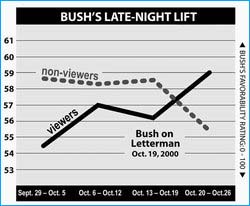Don’t laugh – research shows comedy can give candidates a serious boost

For a week after appearing with David Letterman during the 2000 campaign, candidate Bush’s favorability rating rose among late-night viewers while it dropped among non-viewers.
Presidential candidates can gain a measurable image boost from going on late-night TV, University of Washington researchers have found.
The researchers found that during the 2000 campaign, the favorability rating of George W. Bush went up among late-night comedy watchers for a week after Bush traded comedic jabs with David Letterman.
“Everyone talks about how ’infotainment’ is becoming more important in elections, but can it actually sway perceptions of the candidates? We found evidence that it can,” said Patricia Moy, UW associate professor of communication.
Bush, of course, was not the only presidential contender playing the entertainment card. Rival Al Gore also won points with late-night viewers in 2000 after a Halloween stint on “The Tonight Show With Jay Leno,” but Gore already was more popular than Bush among the liberal-tending late-night crowd.
“The potential influence appears to be stronger for the relatively unknown candidate,” said Moy, who will present the findings Saturday at the International Communication Association’s annual conference in New Orleans.
The study — with UW doctoral candidates Verena Hess and Michael Xenos as co-authors — is based on responses from 11,482 adults to the National Annenberg Election Survey. Pollsters asked a random sample of Americans during the 2000 race how frequently they watched late-night comedy shows, and how favorably they rated the candidates.
In the week before Bush’s Oct. 19 appearance with Letterman, his rating was essentially the same among late-night viewers and non-viewers (56.2 vs. 58.5 on a scale of 0-100). During the week after the show, however, viewers’ rating of Bush rose to 59.0, while non-viewers’ rating of him dropped to 55.5.
The Letterman effect seemed to wear off the following week, when Bush was again doing equally well with non-viewers and viewers.
Some TV viewers, Moy said, may interpret a candidate’s willingness to be a guest on their favorite show as a sign he wants to reach more citizens and cares about their concerns. Indeed, after Bush’s appearance with Letterman, late-night comedy watchers were more likely than non-watchers to base their rating of Bush on their perception that he “really cares about people like me.”
It’s no secret that politicians have been paying increasing attention to media genres not traditionally associated with serious information, from Richard Nixon’s image-softening 1968 appearance on “Laugh In” to Arnold Schwarzenegger’s pre-election interview last year with Oprah Winfrey.
A very popular source of such “non-traditional news” in the 2000 presidential campaign was late-night comedy, according to a separate Pew Research Center study. And Letterman and Leno reach at least 3 million viewers each night.
But Moy cautioned that the benefit to a candidate depends on how he does on the show.
“Research tells us that voters’ political decisions are based on many factors,” Moy said, “including candidates’ issue stances and their ability to interact with citizens and make them feel comfortable.”
And though the late-night comedy audience represents only 22.4 percent of the total Annenberg sample — and is generally younger, more liberal and more male than the overall adult population — Moy said that is a key segment that politicians are trying to reach.
“If you can get a generation to vote,” she said, “that can swing an election.”
For more information, contact Moy at (206) 543-9676 or pmoy@u.washington.edu. The study can be found at http://www.com.washington.edu/Program/Faculty/Faculty/moy.html
Media Contact
All latest news from the category: Communications Media
Engineering and research-driven innovations in the field of communications are addressed here, in addition to business developments in the field of media-wide communications.
innovations-report offers informative reports and articles related to interactive media, media management, digital television, E-business, online advertising and information and communications technologies.
Newest articles

Parallel Paths: Understanding Malaria Resistance in Chimpanzees and Humans
The closest relatives of humans adapt genetically to habitats and infections Survival of the Fittest: Genetic Adaptations Uncovered in Chimpanzees Görlitz, 10.01.2025. Chimpanzees have genetic adaptations that help them survive…

You are What You Eat—Stanford Study Links Fiber to Anti-Cancer Gene Modulation
The Fiber Gap: A Growing Concern in American Diets Fiber is well known to be an important part of a healthy diet, yet less than 10% of Americans eat the minimum recommended…

Trust Your Gut—RNA-Protein Discovery for Better Immunity
HIRI researchers uncover control mechanisms of polysaccharide utilization in Bacteroides thetaiotaomicron. Researchers at the Helmholtz Institute for RNA-based Infection Research (HIRI) and the Julius-Maximilians-Universität (JMU) in Würzburg have identified a…



